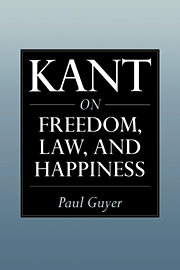Book contents
- Frontmatter
- Contents
- Acknowledgments
- Note on Translations and Citations
- Introduction
- Part 1 Origins
- 1 Mendelssohn and Kant: One Source of the Critical Philosophy
- 2 The Unity of Reason: Pure Reason as Practical Reason in Kant's Early Conception of the Transcendental Dialectic
- 3 Freedom as the Inner Value of the World
- Part II Principles
- Part III Duties
- Part IV Hopes
- Index
2 - The Unity of Reason: Pure Reason as Practical Reason in Kant's Early Conception of the Transcendental Dialectic
Published online by Cambridge University Press: 05 June 2012
- Frontmatter
- Contents
- Acknowledgments
- Note on Translations and Citations
- Introduction
- Part 1 Origins
- 1 Mendelssohn and Kant: One Source of the Critical Philosophy
- 2 The Unity of Reason: Pure Reason as Practical Reason in Kant's Early Conception of the Transcendental Dialectic
- 3 Freedom as the Inner Value of the World
- Part II Principles
- Part III Duties
- Part IV Hopes
- Index
Summary
Understanding provides one form of unity in our experience – let us say, at least for the sake of illustration, that form of unity constituted by the capacity to assign any given experiences a uniquely determined place relative to any other given experiences in the ideal chronology of our experience as a whole. But the unity of experience does not, as Kant sees things, exhaust the forms of unity we must seek among our representations. In addition to the unity of experience sought by understanding, Kant suggests, the faculty of reason aims at “the unity of reason” (A 302/B 359). But what might Kant mean by the unity of reason? Two ways to interpret this phrase readily come to mind. First, we might take it to imply that reason has a single domain of application: there is only one species of pure reason. Second, we might take it to connote the uniqueness of the way in which pure reason functions or the product it aims to yield: pure reason aims to introduce a single special sort of unity into whatever it is to which it is appropriately applied.
Neither of these propositions would initially appear to capture Kant's conception of pure reason. First, Kant seems to suppose, at least in the Critique of Pure Reason, that pure reason can be both theoretical and practical; while there must obviously be some connection between theoretical and practical reason, pure reason apparently cannot be described as having a unique domain of application.
Information
- Type
- Chapter
- Information
- Kant on Freedom, Law, and Happiness , pp. 60 - 95Publisher: Cambridge University PressPrint publication year: 2000
Accessibility standard: Unknown
Why this information is here
This section outlines the accessibility features of this content - including support for screen readers, full keyboard navigation and high-contrast display options. This may not be relevant for you.Accessibility Information
- 1
- Cited by
